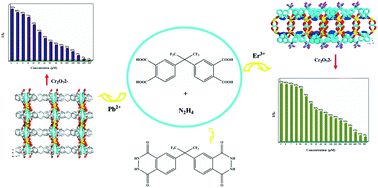6,6′-(Perfluoropropane-2,2-diyl)bis(2,3-dihydrophthalazine-1,4-dione)-based coordination polymers and their sensing properties towards Cr2O72−†
Abstract
Through employing the hydrothermal in situ acylation of organic acids with N2H4, six L12−-based coordination polymers, [M(L1)(H2O)]·H2O (M2+ = Cd2+1, Zn2+2, Fe2+3, Mg2+4; H2L1 = 6,6′-(perfluoropropane-2,2-diyl)bis(2,3-dihydrophthalazine-1,4-dione)), [Pb(L1)] 5, and [Er2(L1)2(ox)(H2O)2]·5H2O (ox = oxalate) 6, were obtained. X-ray single-crystal diffraction analysis reveals that (i) the L12−-based Cd2+, Zn2+, Fe2+ and Mg2+ coordination polymers are isostructural, and they possess a 2D single-layer network structure with a 44 topology; (ii) 5 possesses a 3D network structure, which is constructed from the dinuclear Pb2O812− clusters by the L12− molecules; (iii) 6 possesses a 2D double-layer network structure. Two 2D single-layer networks (the same as those in 1–4) are supported by ox to form this 2D double-layer network. 1D channels (428.9 Å3 for total potential solvent-accessible void volume) are observed in 6. 1, 2, 5 and 6 are found to emit blue light, corresponding to the L12−-centered electronic excitation. Based on the photoluminescence properties, their sensing ability towards the inorganic Cr2O72− anion was investigated. 5 exhibits the better sensing ability towards Cr2O72−. The heavy-atom effect should play a key role.



 Please wait while we load your content...
Please wait while we load your content...